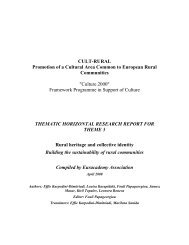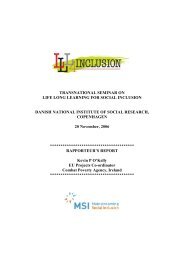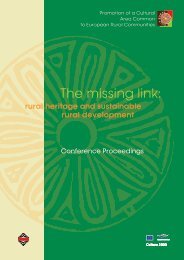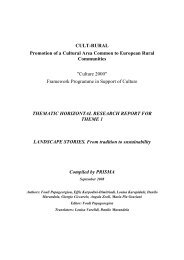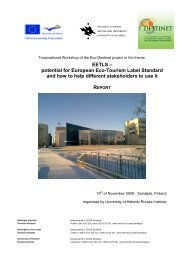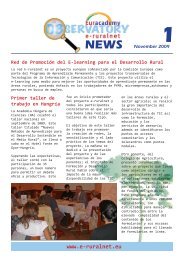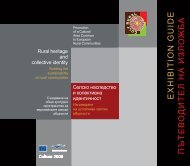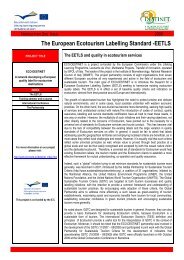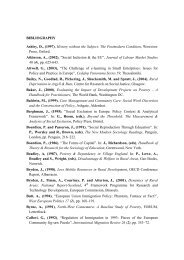Research report by the Jagiellonian University, Poland - cult rural
Research report by the Jagiellonian University, Poland - cult rural
Research report by the Jagiellonian University, Poland - cult rural
- No tags were found...
You also want an ePaper? Increase the reach of your titles
YUMPU automatically turns print PDFs into web optimized ePapers that Google loves.
123.2. Inhabitants of RzeszówJan Stanisław Bystroń (distinguished ethnographer) in his work Ethnography of <strong>Poland</strong>wrote; “And we make one more group separately, namely Rzeszowiacy. And here we alsodeal with <strong>the</strong> borderland, which although a direct prolongation of Małopolska to <strong>the</strong> eats,developed separately. The name Rzeszowiacy (…) includes native, long time ago settledPolish people of <strong>the</strong> western part of previous Ruskie voivodship. The spatial range of <strong>the</strong>ethnographic group in question covered <strong>the</strong> areas situated on <strong>the</strong> right bank of <strong>the</strong> lowerWisłok river-basin and <strong>the</strong> left bank of <strong>the</strong> middle San. In <strong>the</strong> north it spreads to SokołówMałopolski, in <strong>the</strong> east to Jarosław, in <strong>the</strong> south to Błażowa and in <strong>the</strong> west to SędziszówMałopolski.The folk <strong>cult</strong>ure of Rzeszowiacy was formed during over six centuries of historical andsocial development, initiated <strong>by</strong> intensive settlement of people of Polish origin in <strong>the</strong> 14 th and15 th centuries on <strong>the</strong> territory covered <strong>by</strong> influences of Russian people.The favourable natural conditions of <strong>the</strong> Sandomierska valley – relatively rich soils, awell-developed net of rivers and streams and mild climate made agri<strong>cult</strong>ure <strong>the</strong> basic industryof Rzeszowiacy. At <strong>the</strong> same time, <strong>the</strong> source of extra money was weaving, mainly producinglinen but also woollen cloth. These factors decided that Rzeszowiacy were relatively richer,which resulted on one hand in <strong>the</strong> feeling of superiority in relation to Lasowiacy who were<strong>the</strong>ir neighbours in <strong>the</strong> north, and on <strong>the</strong> o<strong>the</strong>r hand in forming a separate group ethosexpressed in monumental buildings, in which <strong>the</strong> pillar construction was applied whilebuilding houses, richly equipped interior, developed decorations and <strong>the</strong> attire, in which wecan see elements of <strong>rural</strong> and noblemen fashion, as well as rich customs and rituals.4. The folk attire4.1. The Podhale attire as a symbol of <strong>the</strong> regional identityThe Podhale attire, originates from shepherd-Wallahian tradition shared <strong>by</strong> many groupsinhabiting <strong>the</strong> Carpathians, which can be proved <strong>by</strong> e.g. “Wallahian” shirt or cloth as a basicmaterial for production of many items of clothing. During <strong>the</strong> previous centuries both afemale attire as well as a male one have changed and adopted new elements. Shaped <strong>by</strong>environmental and social factors, and also <strong>cult</strong>ure fashions coming from both <strong>the</strong>neighbouring regions and <strong>the</strong> elitist strata it was a kind of a barometer of changes occurringin <strong>the</strong> Podhale community.




